City guides


Things to do in Hobart
The second oldest city in Australia, Hobart is indeed a fascinating place to visit. Dating back to 1804 when it grew out of the penal settlement on the island, Hobart boasts many beautiful historical buildings and areas, all beneath the majestic backdrop of the often snow-capped Mount Wellington.
There are many rewarding ways to spend your time in Hobart. Visitors can take a stroll along the riverfront and admire the Georgian and Victorian architecture, then visit Battery Point to see buildings made out of Hobart's golden sandstone, which gives parts of the city a warm, golden glow. On a Saturday, it's worth visiting Salamanca Place, where the sandstone warehouses date back to the 1830s and stalls line the maze of streets selling everything under the sun; the surrounding art galleries, theatres and cafes will cater to visitors' every entertainment need.
Travellers should also check out the Tasmanian Museum and Art Gallery to see the stuffed Tasmanian Devil and the extinct Tasmanian Tiger, or head to the Maritime Museum of Tasmania to learn about the whaling industry, see early Aboriginal boats and even shipwrecks. Hobart's wine industry has exploded in recent years and a day out in the Coal River Wine Region and D'Entrecasteaux Channel, sampling some of the region's wines and gourmet cuisine at Moorilla, one of Australia's most awarded vineyards, is not to be missed.
Travellers should look into buying the See Tasmania Card, which grants access to about 35 attractions across Tasmania, as well as tours and other discounts.
Hobart is small, compact and easy to explore on foot or by bicycle. There is an efficient local bus service, the Metro, for which day passes are available. Ferries run between Franklin Wharf and tourist spots around the harbour.
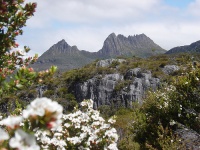
Cradle Mountain
One of Tasmania's most popular attractions is the Cradle Mountain-Lake St Clair National Park. Placed on the UNESCO World Heritage list in 1982, its landscapes include ancient rain…
Cradle Mountain
One of Tasmania's most popular attractions is the Cradle Mountain-Lake St Clair National Park. Placed on the UNESCO World Heritage list in 1982, its landscapes include ancient rainforest and alpine heath lands, interspersed with button grass and stands of deciduous beech trees. Trails winding through forests of King Billy pines stretch around the mountain and offer superb day treks, and the 50-mile (82km) trek from Cradle Mountain in the north to Lake St Clair in the south is Australia's most famous bushwalk. The Park is equipped with mountain huts that offer accommodation for long treks, and Cradle Mountain Lodge offers log cabins in a tranquil setting. Lake St Clair, a narrow 10-mile (15km) long waterway in the south of the park, is Australia's deepest natural freshwater lake.
Website www.parks.tas.gov.au/index.aspx?base=3297
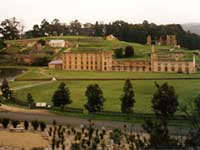
Port Arthur
Port Arthur is located in the far south of Tasmania on the Tasman Peninsula, which in the early 1800s was originally a timber station. In 1833 it became a prison settlement for mal…
Port Arthur
Port Arthur is located in the far south of Tasmania on the Tasman Peninsula, which in the early 1800s was originally a timber station. In 1833 it became a prison settlement for male convicts, and quickly established a reputation as being 'hell on earth'. Today Port Arthur lies among 40 hectares of English Oaks and magnificent gardens as a memorial to Australia's convict past. The Port Arthur historic site offers an inclusive all day ticket, which includes a guided historical walking tour of the ruins and restored buildings, a harbour cruise and access to the visitor centre and interpretation gallery. One of the more popular features of a visit to Port Arthur is the Historic Ghost Tour run at night. Port Arthur is 65 miles (100km) southeast of Hobart. Visitors should allow about an hour and a half to enjoy the scenic drive along the Tasman and Arthur highways.
Website www.portarthur.org.au
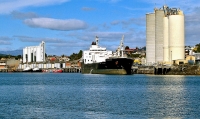
Devonport
Tasmania's third largest city, Devonport is the gateway to the island state, situated as it is in the centre of the north coast, at the mouth of the Mersey River. It is the point o…
Devonport
Tasmania's third largest city, Devonport is the gateway to the island state, situated as it is in the centre of the north coast, at the mouth of the Mersey River. It is the point of arrival for car ferries from the mainland and it also welcomes visitors at its modern airport. The city is three hours by road from Hobart on the Midlands Highway. The city has a number of attractions for visitors, including aboriginal rock engravings, a maritime museum and a cycling-walking track that extends around the picturesque foreshore, past the Olympic Swimming Pool, to the historic Don River Railway, which operates vintage and steam trains. The city's central location makes it an ideal base for discovering the wilderness experiences of northwest Tasmania, especially the Mt Cradle National Park.
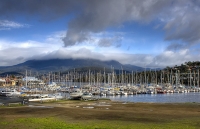
Mount Wellington
Visitors in Hobart can't help but notice that the city's skyline is dominated by the majestic Mount Wellington, which towers over the city at 4,170 feet (1,271m). Travellers can en…
Mount Wellington
Visitors in Hobart can't help but notice that the city's skyline is dominated by the majestic Mount Wellington, which towers over the city at 4,170 feet (1,271m). Travellers can enjoy the incredible panoramic views from atop the mountain by taking a bus to Fern Tree and walking a steep zig-zag track to the top. It is frequently snow-capped, even during the summer months from time to time, and the lower slopes are thickly forested. Those who choose to rent a car can even enjoy a scenic drive to the summit. Mountain biking is also a popular sport in Wellington Park, so enthusiasts can look into hiring a bike and some gear to enjoy the wonderful single trails on offer.
Website www.wellingtonpark.org.au
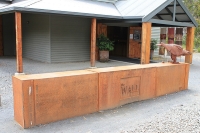
The Wall in the Wilderness
'Something special is taking place in the heart of Tasmania, and you are invited to witness its creation'. These are the words that greet visitors on the official website of The Wa…
The Wall in the Wilderness
'Something special is taking place in the heart of Tasmania, and you are invited to witness its creation'. These are the words that greet visitors on the official website of The Wall in the Wilderness, and by all accounts, the sense of excitement they communicate is well earned. An ambitious project, Australian sculptor Greg Duncan aims to create a massive frieze, carved from gorgeous Huon Pine, depicting the best and worst of Tasmania's history from pre-colonial times, to trailblazing European foresters, to the extinction of the Tasmanian tiger, and the advent of hydro-electric power in the region.
The sheer scale of the undertaking is mind-blowing; Duncan aims to use 50 panels, each one metre long and three metres high, carved front and back, giving a grand total of 300 square metres of realistic engravings. Duncan says he hopes that viewing the Wall will be 'an educational as well as an artistic experience', an important reminder of both the successes and mistakes that characterise Australia's history as a nation. The work is ongoing but the carvings are already very extensive.
Website www.thewalltasmania.com.au


